Assignment Three asks that I take some time to review my sketchbook and project work for Part Three. I should record my reflections and consider the ideas and approaches I explored and what I thought about it and learned. It is suggested to consider a few questions as discussed below in the Reflective Account.
REFLECTIVE ACCOUNT
The capacity of objects, and images of objects, to act as proxy bodies, standing in for, or, signifying human presence, or absence.
Engaging with artwork and artists in my research and my own artmaking process made me aware that Contemporary art and the way it transmits a message has become increasingly complex, and much different than before. I am thinking about Readymades, art that became detached from aesthetic ideas. My idea is that art is almost always a reflection of an era, and therefore it will be difficult not to see narrative in art. I do think I became aware of the power of art as a tool to act within society and that this is not always about what art is trying to say (narrative), but its affect, and the message could be hidden or secondary. I learn that neither classical art or classical culture privileged strict sequential time. (Small, 1999) I have worked with different media during my making process and found that I would consider opening myself to performance and installation work.
The work of Rachel Russell and Cindy Sherman spoke clearly about possibilities in art to act as proxy bodies and signifying human presence. The making of a paper dress and other props opened up my imagination around objects and their power.
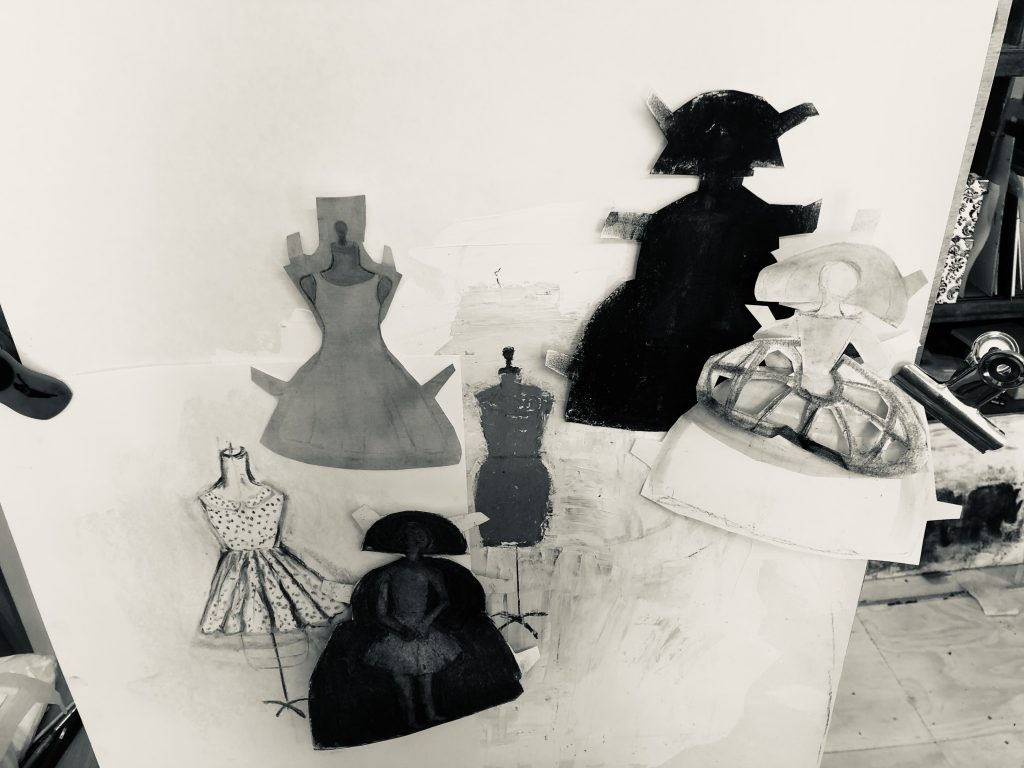
Ideas around transformation, memory
I think that although not all artwork is about narrative, it does tell a lot about circumstances ( contemporary happenings at that time?) around the object of art, sometimes when ideas of visibility or invisibility are explored, it could become a comment and or documentary on ideas (such as colonialism, consumption, place, activism, feminism, emotion, etc). I saw powerful work in this part of the course, work by P Guston touched me for the determination of the artist to follow his passion and be brutally honest and vulnerable about it. Looking back on his body of work, I think so much of his work was ‘judged’ wrongly. I was fascinated by how his work could be transformed and enacted. The power of performance art became a very interesting field for me to learn and explore. I understand visual arts compared to text or writing have a problem with space and time, if we think of what we see when we look at a picture from one vantage point – it is one moment in time. When I think of the Las Meninas I am aware that as a viewer, it takes time to grasp spatial relationships and complexities of describing the actions which occurred at the time of making/showing (what the artist presents). It does tell us who was there at that moment. I would like to understand more about the idea that visual art is a ‘temporalized ‘ space, and how it suggests that moment within the fleetingness of time.
In a recent student meeting, a photography student shared work he did on Repeat photography. Having looked at his slides I understood it as repeat over time of the same place, time is linked by the event that depicts what has happened (captured in the image) at an earlier time. It is clear that the effect of this idea of repeat lies in the ability of photographs to show the link (two images are placed together and the viewer understands this depiction over time) Is it reality and time? I see value in documenting. I do think this is what Las Meninas became to me during my projects. A quote from Roland Barthes from his book, Camera Lucida was used in this student’s presentation that stayed with me: “This new punctum which is no longer of form but of intensity, is Time, the lacerating emphasis of the noeme (that-has-been) its pure presentation. ” (Barthes,1980:96 ) I had the book as a saved document (Monoskop) and looked at the quote:
” I now know that there exists another punctum (another “stigma tum”)
than the “detail.” This new punctum, which is no longer of form but of intensity, is Time, the lacerating emphasis of the noeme (“that-has-been”), its pure representation.” I would like to consider this within my parallel project.
The potential of visual sequence to create a narrative
I am considering ideas of intentional storytelling, visualization techniques to communicate with an audience – sequence stays ‘organized’ and follows a timeline; and I presume makes meaningful connections and could be quite ‘universal’ as a language between different cultures. Using colour ( for mood and lightning) and to separate background, foreground, and middle ground with shapes and values and empty/negative space. I was not successful at creating a visual sequence to create a narrative in my project. I was taken by all the elements of the storyline and should have worked harder at creating a series. I am drawn to Paula Rego for her ability to tell stories in her works – her imagination and exploration of these thoughts are very personal – the hidden is explored and I could learn from this. I think it opens up themes such as things that we mask or conceal because it could be embarrassing to deal with them in such an open way.
I do think that my learning blog can be looked at as a visual sequence as it offers visual ‘evidence’ about a personal story of my own development as an artist, and a documentary of the body of work I developed in this time. I also consider the use of photos of my process to show my tutor how work started, developed, and the finished product – it is a visual sequential event I am asked to create. I decided to go back to the site I used for the paintings in part 4 (oil and pastel) and re-photograph the scene monthly. The trees are already starting to push out green leaves and the dam will have less water – it is now summer here, and our rainy season is in the winter months. I can also consider scale for the rest of the images I could create from this process.
Disruption of a visual sequence to create a nonlinear narrative
Here I think about events that do not follow a chronological order, like being in reverse order or going back and forth between past and future events. It reminds me of many movies I have seen that use flashback scenes or using different scenes in terms of place and time. It shows the importance of planning and organizing a narrative – you need to be aware that viewers have to be able to follow the narrative.
I gave some thought to the use of Hypertext in our study material, could this be seen as a form of disruption – we use electronic links with graphics, sound, video to get more information. One can access these fragments with information without reading the hyper document serially.
The rupture of pictorial space by a reflective surface or framed view.
On a more philosophical side, I think that although we experience time as linear, history, even in art, is showing that things are always returning and will rupture the present.
Making process
Developing a final piece from work I have done in previous projects as a way to explore and reflect on my learning and making process. I am more aware of an uneasy relationship with clothing in terms of social and economic status over the history of many cultures, which was driven by consumption and new markets opening when modern life advanced from the medieval. Working with reflections opened my ideas on how we see the world around us. The form of the mirror made of brass became part of the work which I thought I could develop. I had an earlier work where I played with the idea of a part of a beehive I collected on a walk. The images were put onto a paper with a cyanotype print that did not develop into the desired outcome. I used this paper to develop my ideas, as the shape of the mirrors reminded me of a beehive. ( my tutor remarked in our session that she would have liked to pour honey over this work – and it made me consider how I could use the material to explore the reflections further)
It seems that I have developed a series of pieces which I will present below.
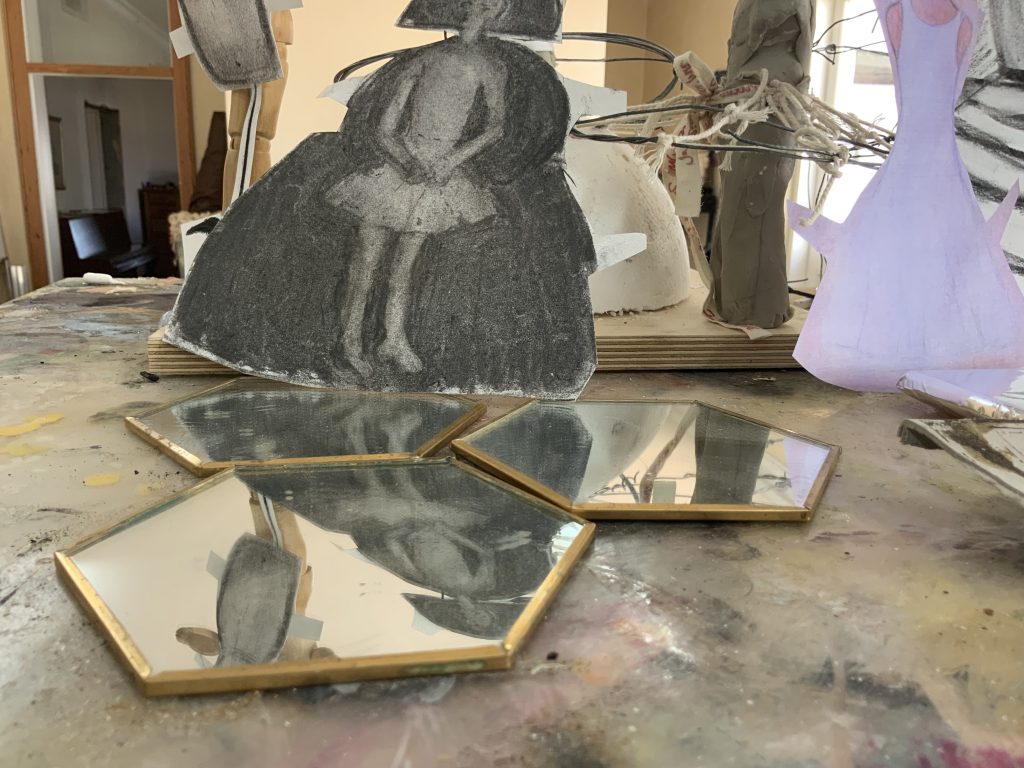

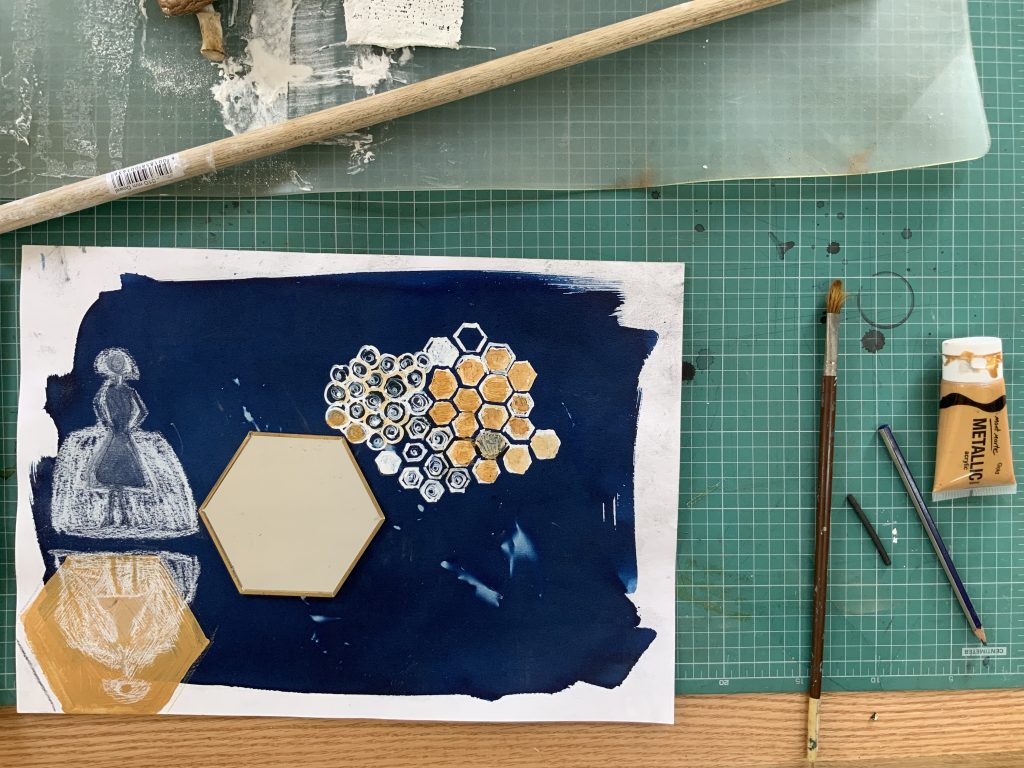
It feels like the work is taking on its own narrative – a dreamlike experience. I do not think the Infanta will stay important in this work, as it is about my own ideas in my head to push my explorations in making further, even though it feels I am in a void.

In the work below, I worked with the idea of bringing ideas together to question the focus on fashion and femininity as I looked at the dress the little Infanta wore and was the fashion of that era. I worked with the idea of the Combine but did not continue to explore the idea and make it an effective piece of work. During a tutorial on this work, my tutor suggested I look at Eva Hesse, namely drawings she made for her sculptures. After a google search, I was reminded of this passionate and in-touch sculptor, who explored materials, writing, painting, drawing in her practice. I decided to revisit a painting work and, which by now makes more sense to explore and brainstorm directly onto the paper support. It is as if a heavy load of fear and uncertainty was lifting off my shoulders. I explored on this painting and used rope, wire, and aluminum foil.
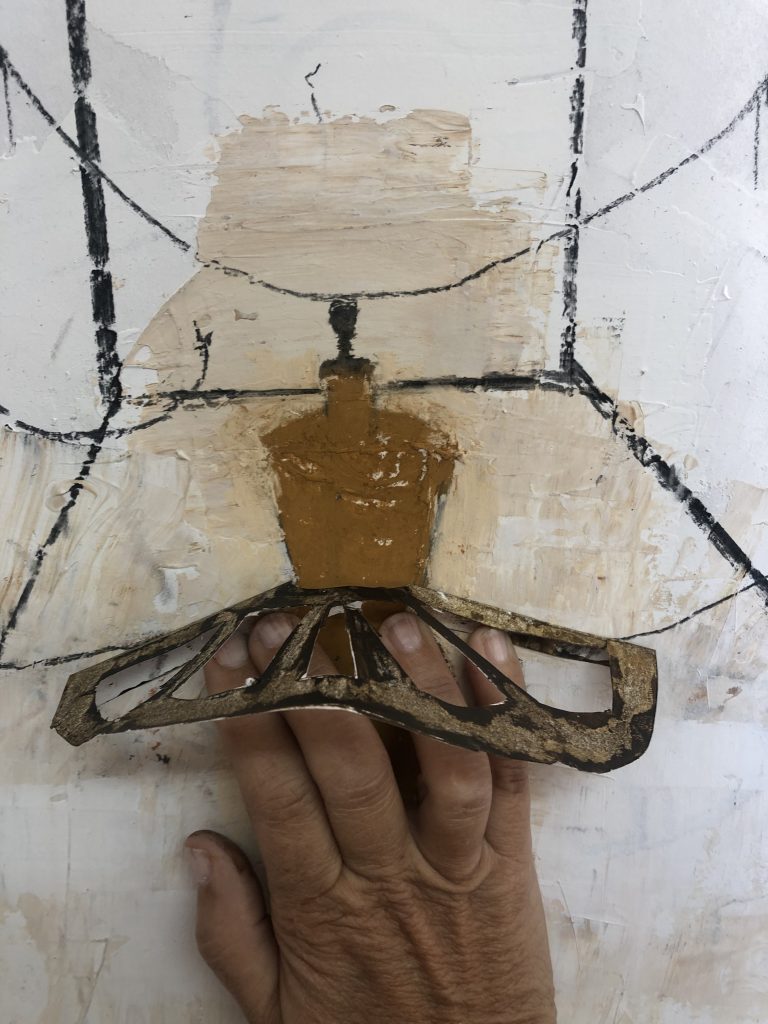
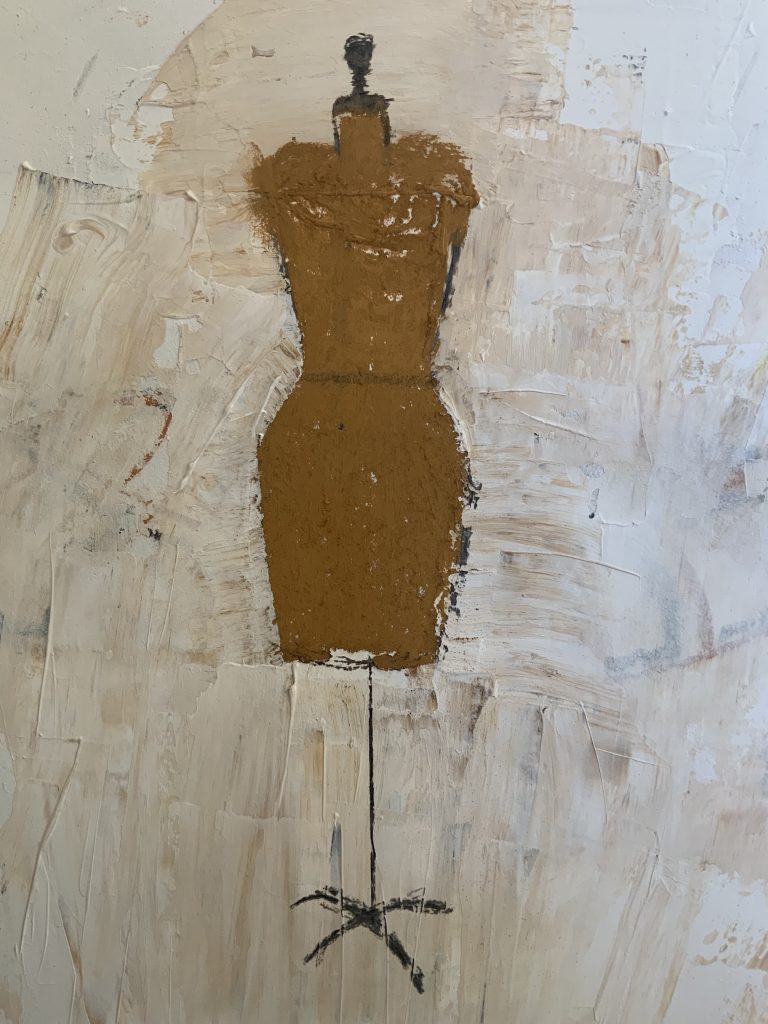
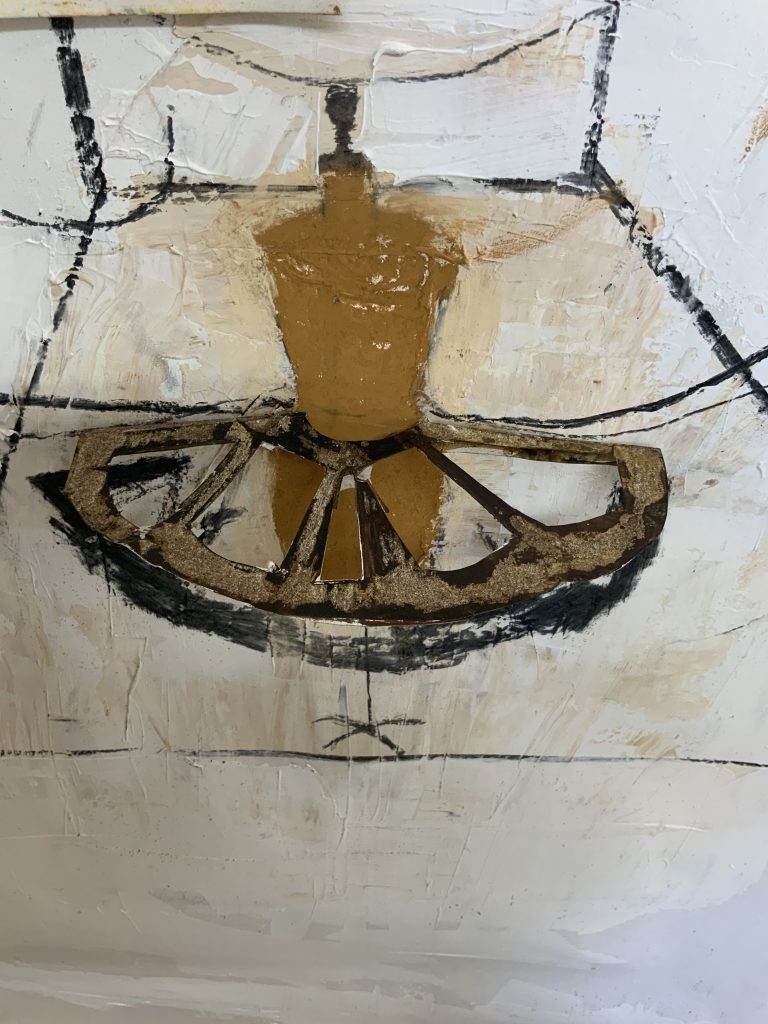




I decided to keep the ideas of revisiting the dress I made of tissue and newspaper; thinking of it as a collage and the ‘missing’ or absent body. I think it is about how one makes content with materials – and I can only continue to explore different materials in my making.
I have a big canvas and hung the dress over the canvas. I am influenced by the next project in the course, which I have already started working on, so in a way, this is an investigation into using a stretcher as a vehicle to support an imagined body. As a combine it could work, I have to look at the composition and how it will stand or hang in space.
I keep it hanging in my studio to consider working on more ideas. I have always wondered how the dress would compare to the Guardian Infante style dress or the Infanta in earlier work, so I used an umbrella and made the dress stand on it. I considered how my paper dress could pop up under the umbrella.
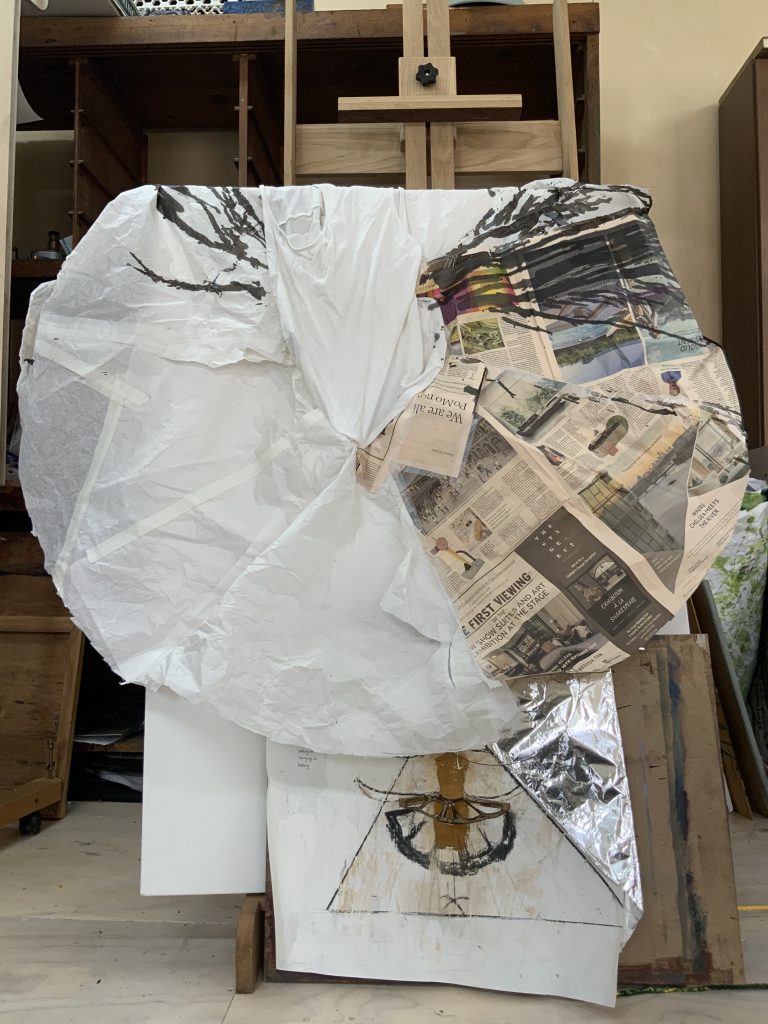
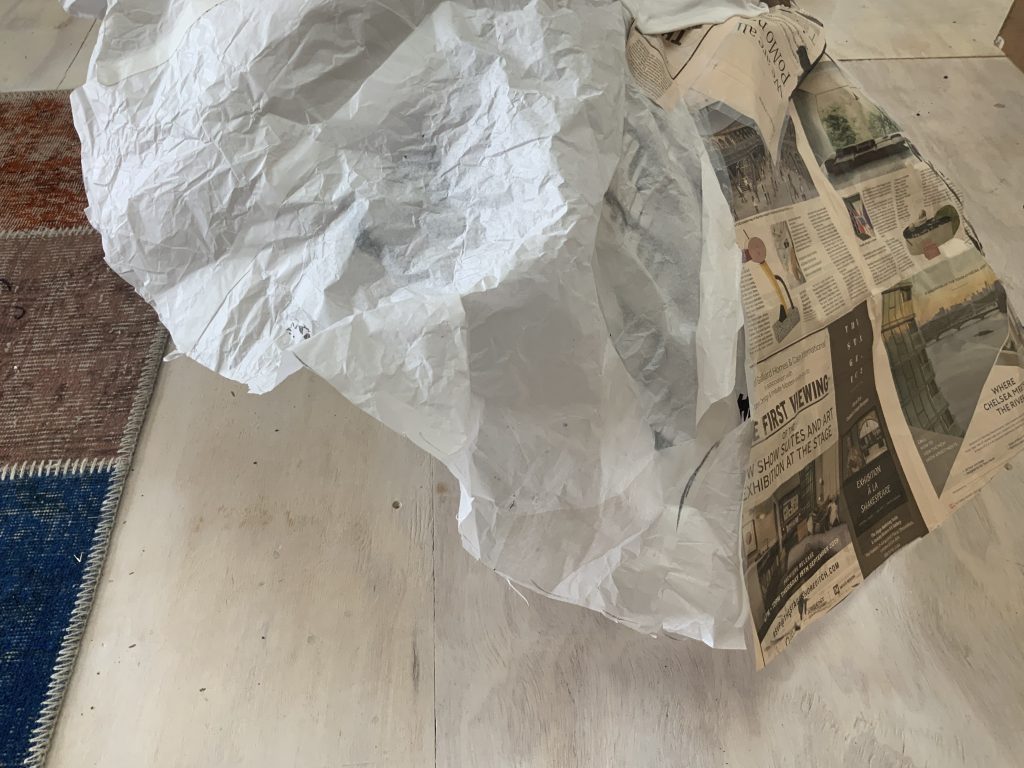
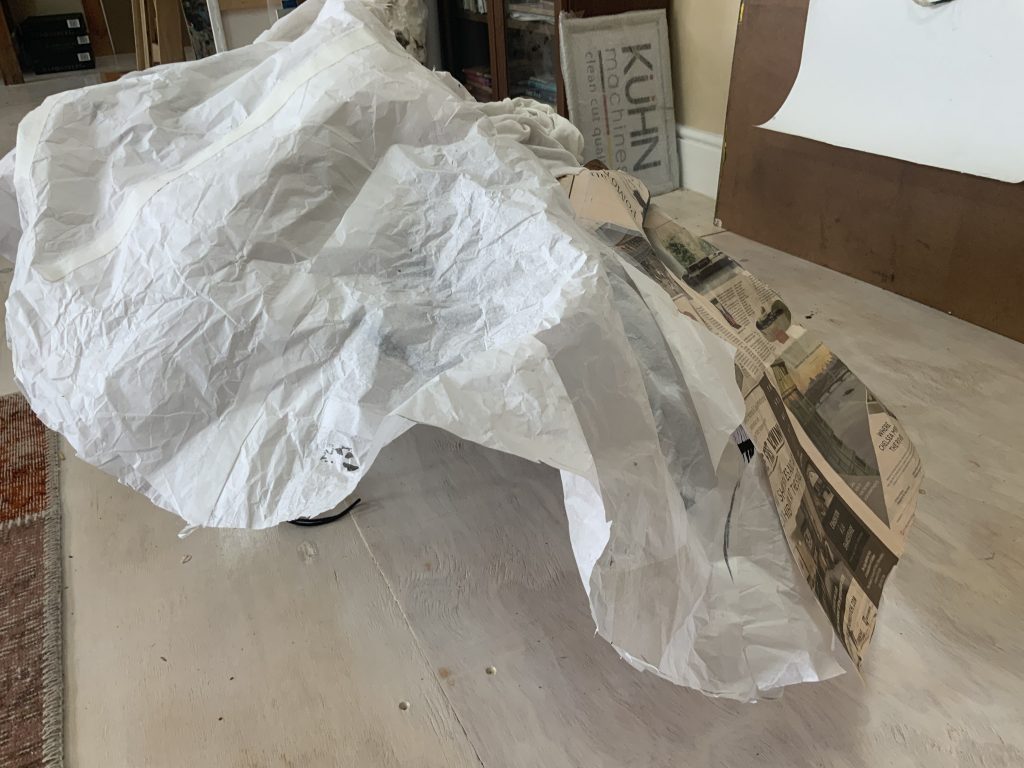
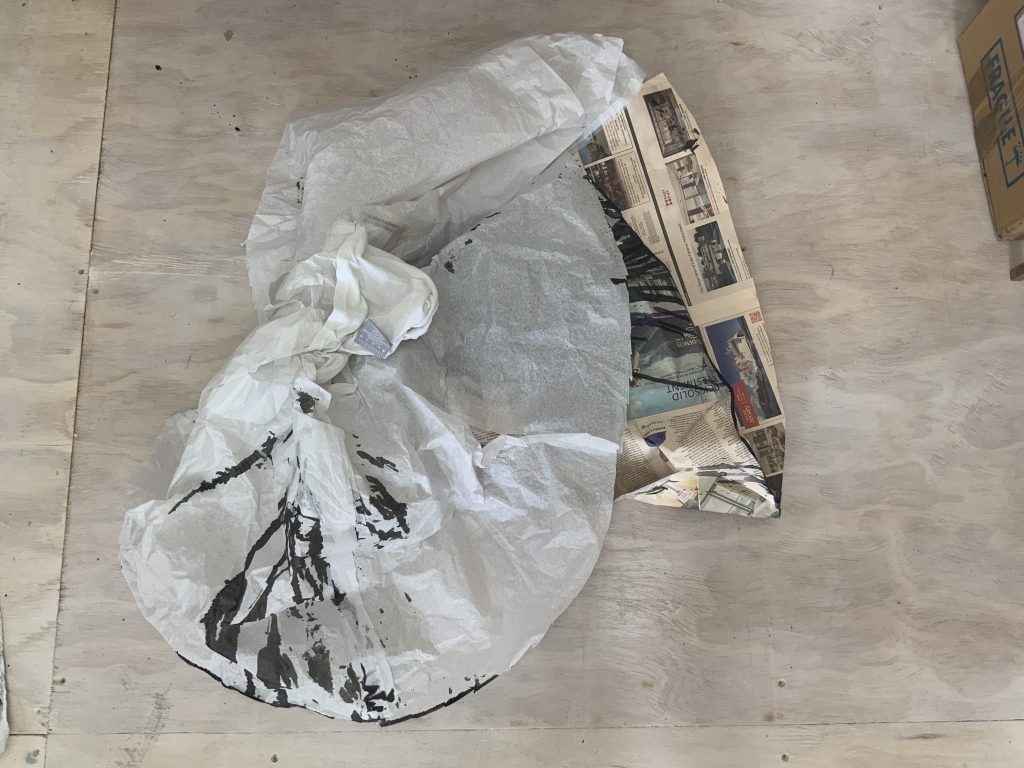


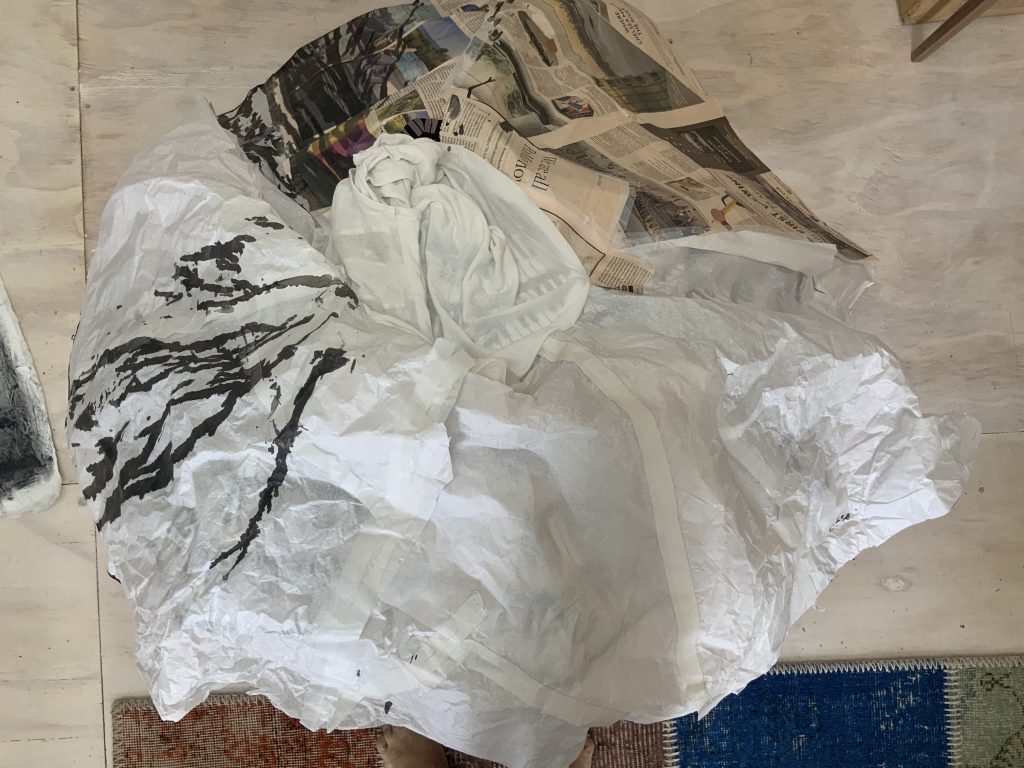
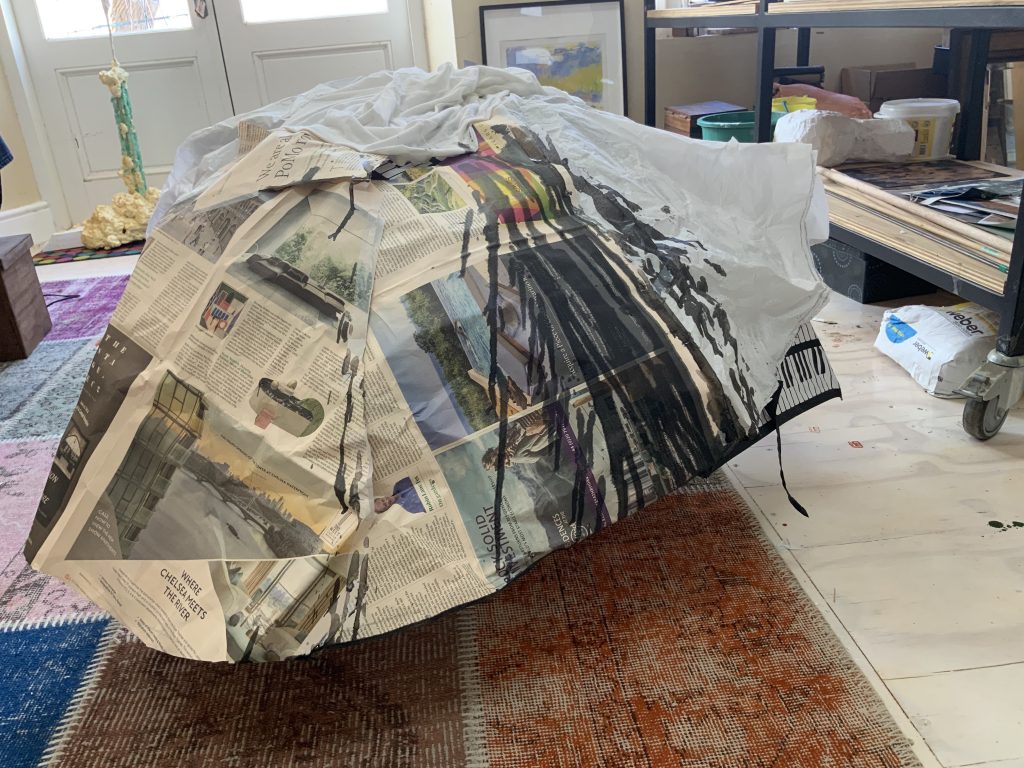
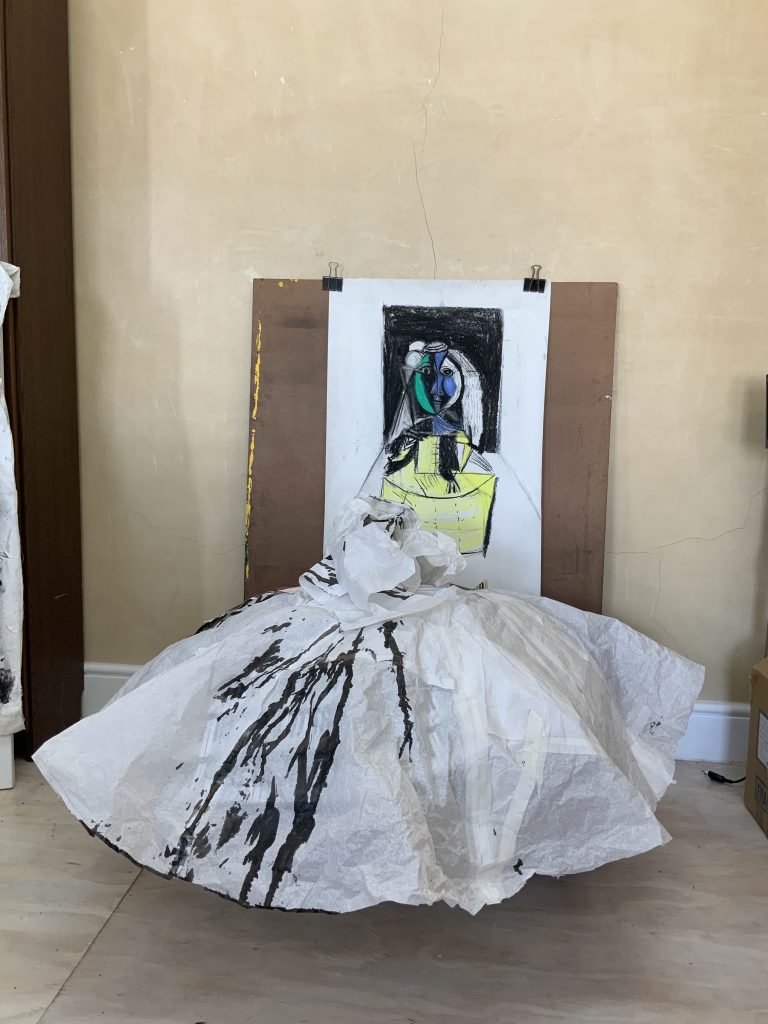

A friend who works as a stylist in the fashion industry shared a photo of a model he recently worked with. (he is from Spain and is following my Las Meninas explorations on Instagram) I think by now I am learning something about (my own) labor versus skill. I have a flimsy handmade dress, I do not have the mastery of the materials, I am not a dressmaker or designer, but I explored this field and engaged with ideas of fashion, beauty, feminism, culture, memory, and some form of the ephemeral. The newspaper is not so ‘bendable’ as the tissue paper, almost as if they fight against each other.
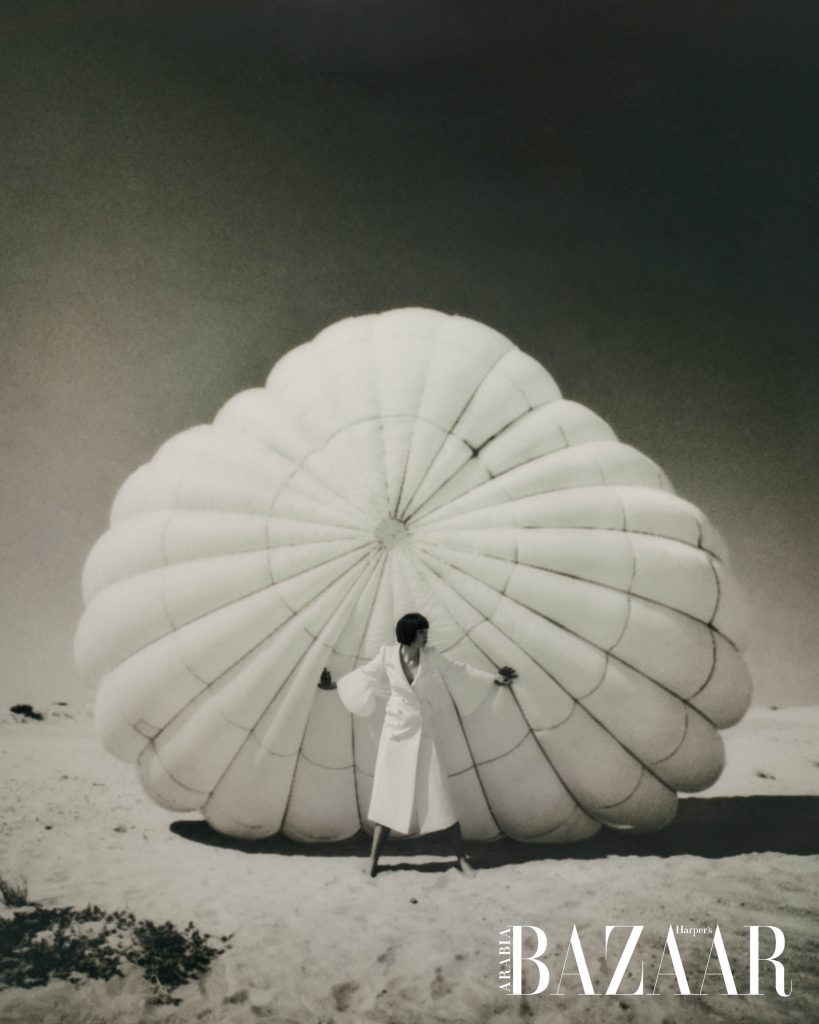

I read the article about the model, Azza Slimene, who features in both the images of this Arabian Harpers Bazaar edition. She is an Arab-born young woman from Tunisia who feels strongly about feminism and gender equality, and who is an activist for sustainable practices in fashion and film. The photos were taken within and around a heavy hot air balloon in the Dubai desert.
Le John, writes in a review of Practice the following: “Many contemporary practices involve research and collaboration, and many of the arguments in the anthology support this. Numerous authors – such as Julia Bryan-Wilson and Gerhard Richter – emphasize that it is not possible to master a new idea, as an idea will always grow and change. They argue the onlything that can be mastered is the ability to let go, experiment, and welcome the unpredictable and the weird”. (Le John, 2018:595)
I searched google for balloon dresses and came upon a Norwegian fashion designer, Fredrik Tjærandsen, whose dresses can be called performative. He showed these designs at his BA graduate show at Central Saint Martins in 2019. The range was called Moments of Clarity and the bubbles were made from vegan, pesticide-free rubber that engulfs the wearer before deflating, challenging the limits of what womenswear, garments or sculpture might be. The clothing is temporal and will deteriorate and disappear in time. I do like the idea of the dress as clothing also becomes a sculpture as well as the temporal element to it. Tjaerandsen said that his collection was inspired by the moment which he calls indefinable and when self-awareness becomes active and sentiment. To him, it was an experimental practice of reacting and creating his own expression of that moment.
I feel I should make peace with the unpredictable and experimental within this assignment – it shows an unfinished product, but it became a way to learn and develop ideas that could grow. I consider the dress versus a balloon – floating and not restricting.
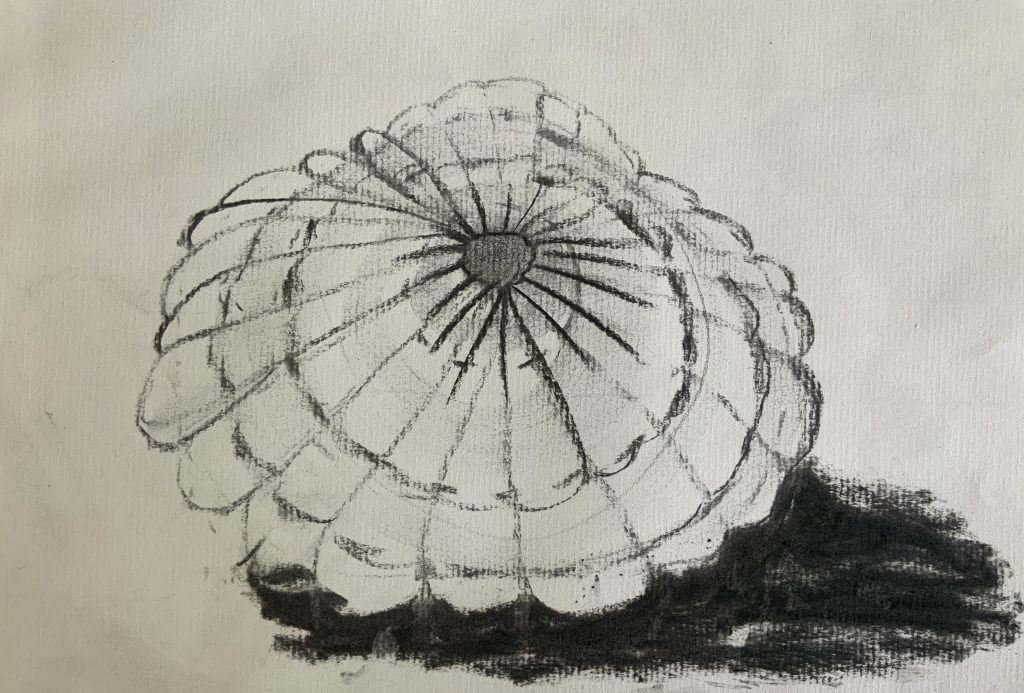


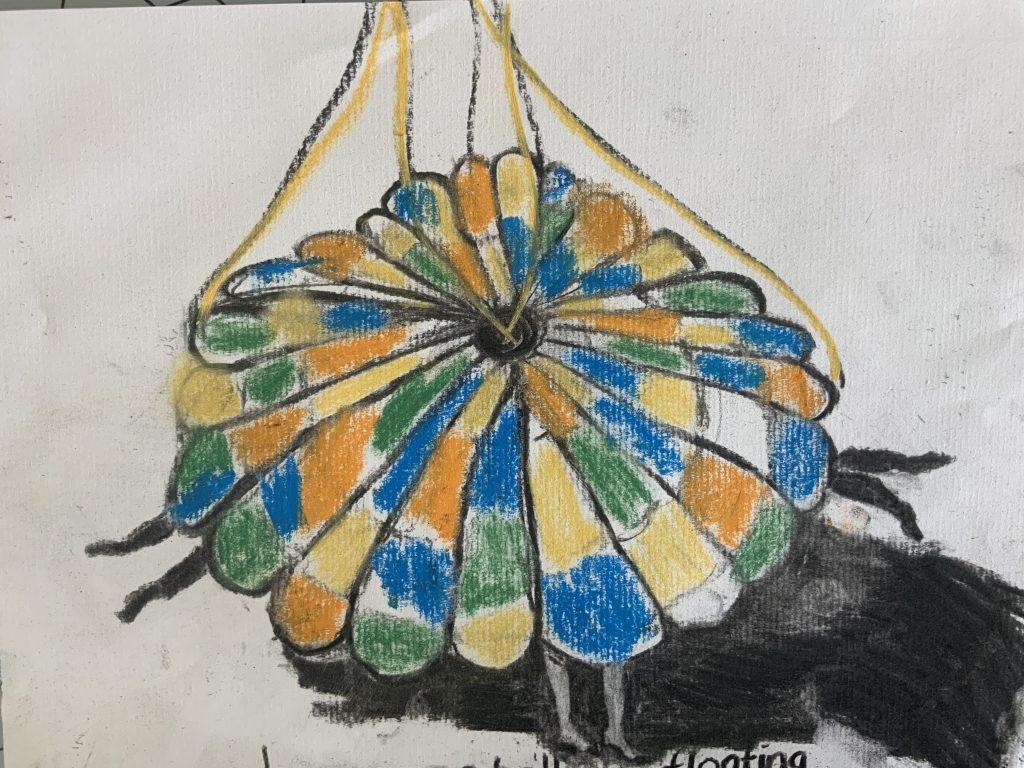
In the below images one can see how the dress can be used as in the bubble or in a deflated mode. Here the designer is showing his own design. To me, the process of developing his ideas is good learning and his work is almost surreal.
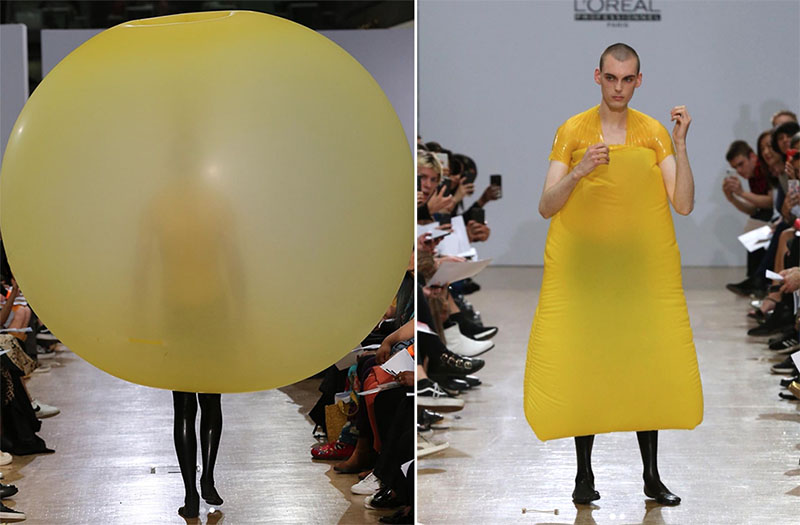
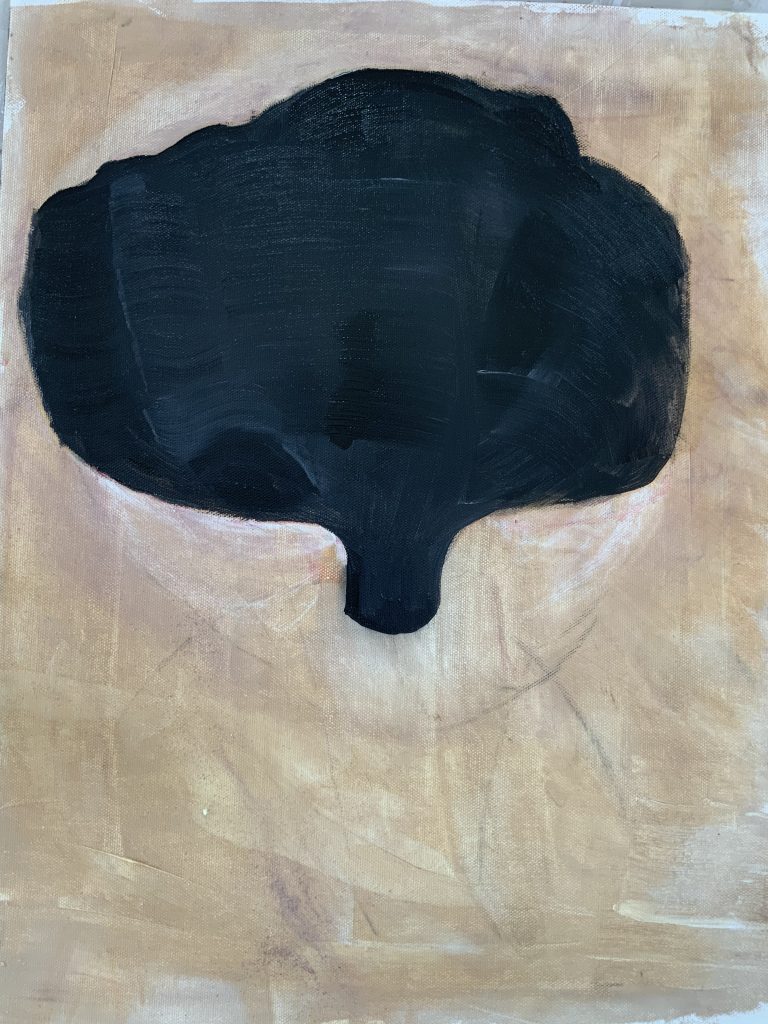
It could be a dress that flew up and became as light as the air.
I decided to focus on what I enjoyed: forms of the dress and Las Meninas as appropriated by other artists and art history that carries a deep history of culture. In Fig. 31 the black dress painting is turned upside down, could swop it for a black plastic bag?
By now I came upon the work of an American artist, Simone Leigh, who also developed her material work around the Las Meninas, see Image 32 below. I read about how she questioned culture around the female body, race, beauty, and community with her ceramic work, called, Las Meninas, 2019 in the notes of the Cleveland Museum of Art, (Acquisitions, 2019) In this archival document, the writes mention that Leigh referred to body painting traditions, especially the use of white powder to guard the skin against the sun; something, which I still see regularly in my own country, as a connotation between protection and communication. In South Africa a type of white clay powder is used on the face as a protector against the sun and ultraviolet radiation. I think about the little Bucaro the Infanta holds in her hand and what I read during my work done for project 3. exercise 1.2 in my blog. In South Africa, there have been concerns raised about the high levels of quartz found in all the samples of the lighter clay that is used, as well as soil around mines where people live, as it might pose a health hazard like radiation and skin rashes. It is a known fact that the clays are supplied by traditional healers ( with indigenous knowledge) and are sold locally for topical cosmetic applications. I would like to look at this as further development of ideas and will discuss this in my Parallel project.


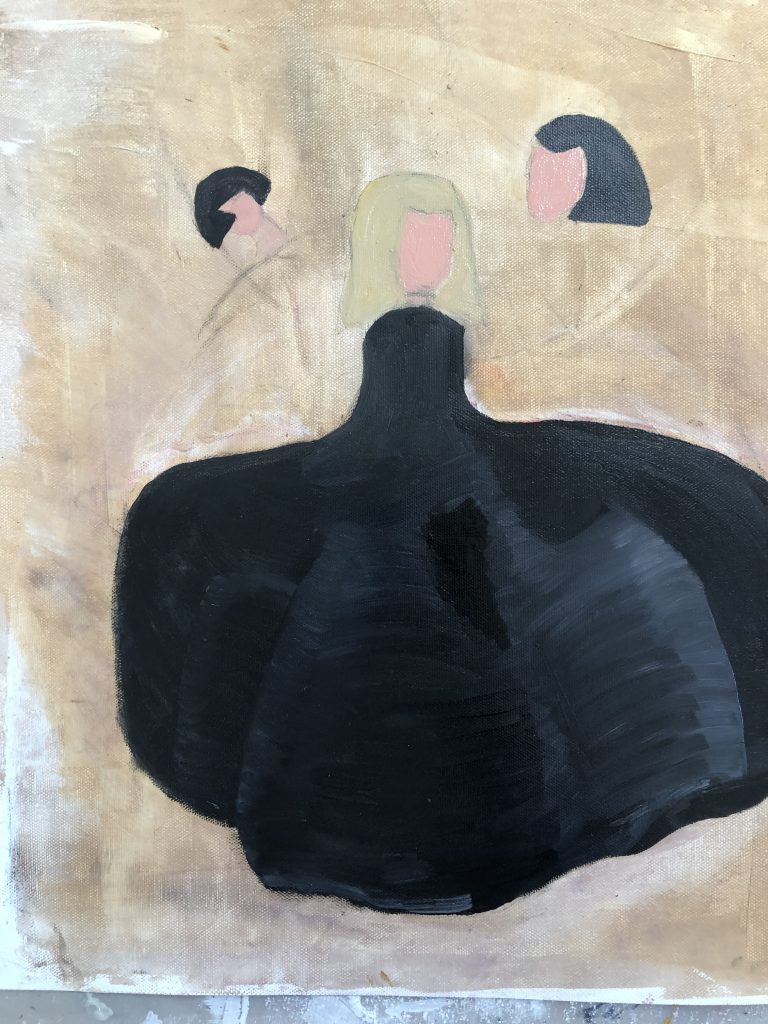
I decide to work with the earthy colour of the Bucaro as the background for the painting. I did not want to make the faces expressive and more figurative. I worked with Persian (Indian) red, Lamp black, Yellow Ochre and a little Tinta cielista jasna, all oil paints. I added linseed oil for a soft mix and worked mostly with a big brush and wet into wet. After all, it is about ideas around what could happen when a dress becomes a stand-in. I wonder if the work says something about the painter, the subject, and the viewer? I see the painting as part of the other works I have done around the Las Meninas and think the process will continue as exploratory work.
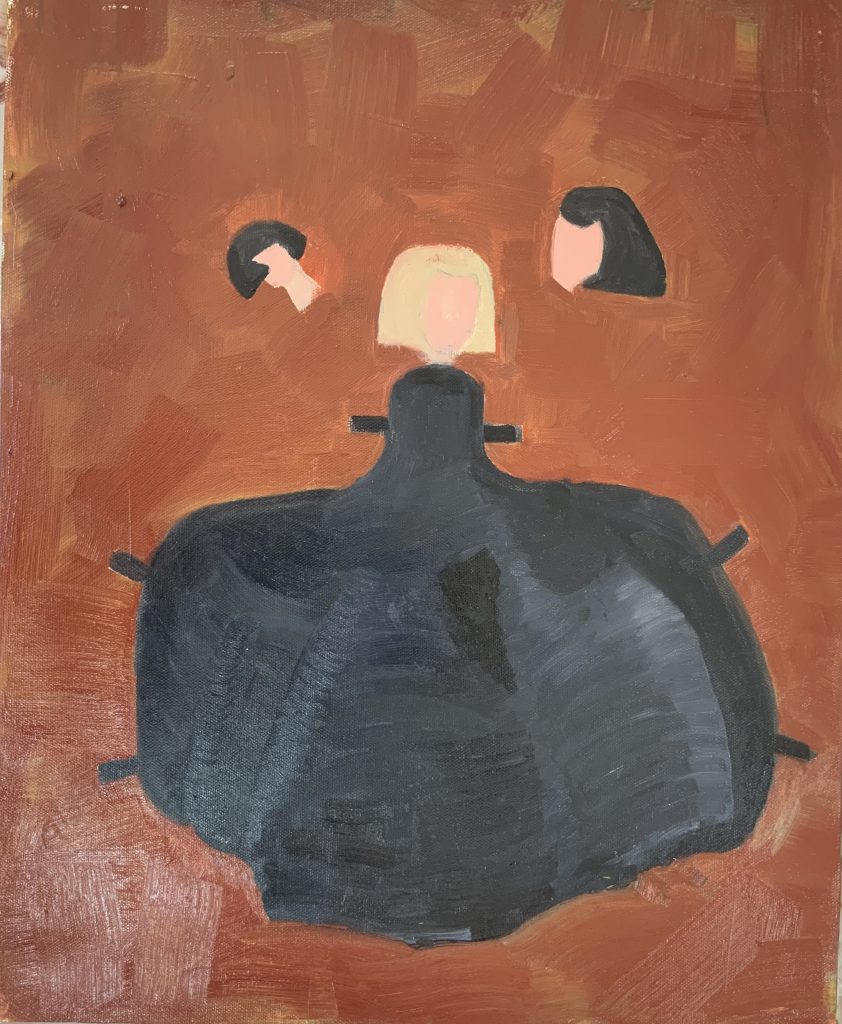
I decided to share the work with my tutor as I added and changed the original assignment work.
Method exploring with video and dresses
I keep the below explorations as part of the original assignment to show more material work I experimented with during this assignment. It also reminds me that some work is not considered good enough and how I could learn from it.
I recently saw work by artist Trish Morrissey and she became my inspiration for thinking of developing the ideas of a dress as a stand-in for the body. As a photographer this artist explores self-portraiture through performance, I have also looked at her work of exploring archives, and would make work in response to the collection like on a character. What I found interesting is that she uses performance (and wit) as tools to investigate the boundaries of photographic meaning. She sees most of her work in which she features herself as the protagonist, and not as a self-portrait per se. I see in her work a process of re-enactment.
The surrealist work of females like Rachel Baes was also considered when I looked at the undergarment piece worn under the wide dresses, something that stayed fashionable over a long period of time.
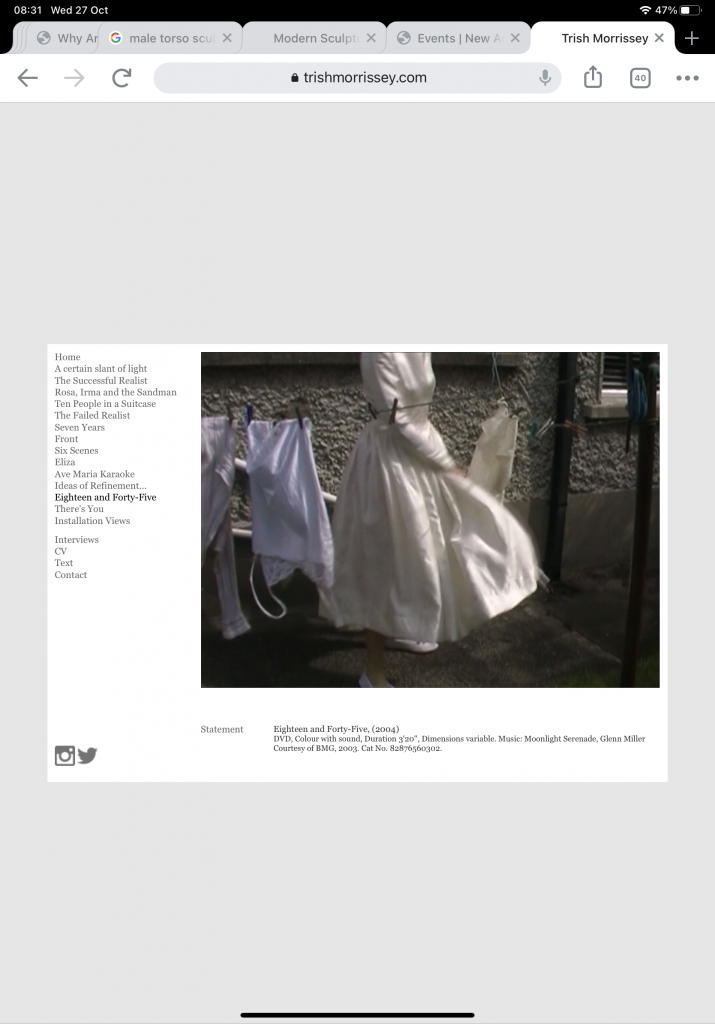
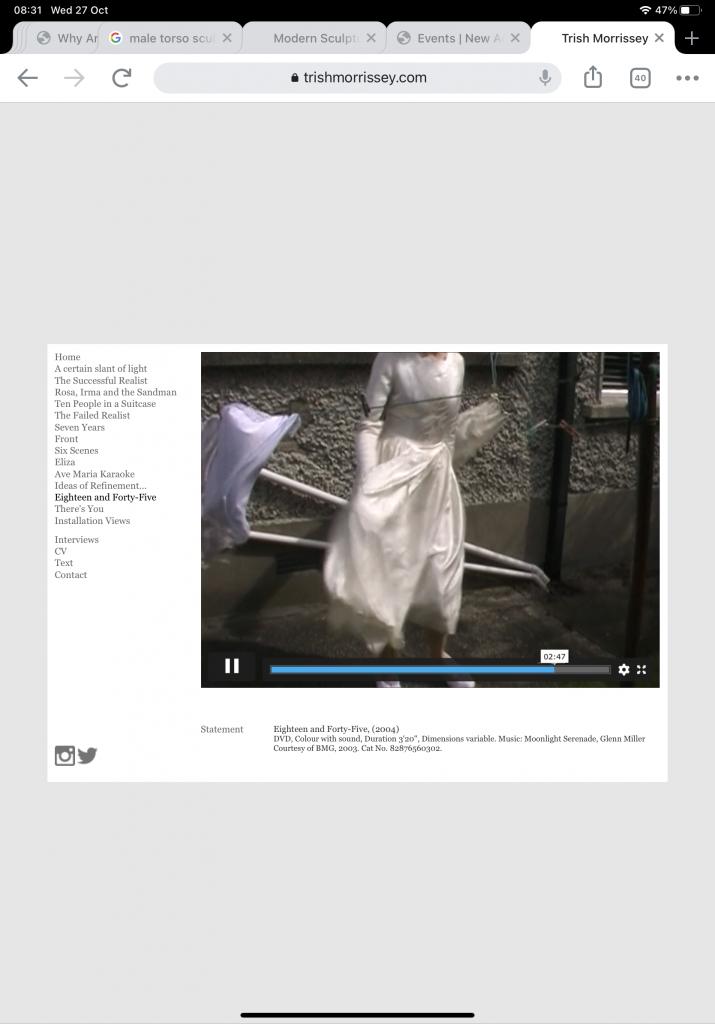
My stage is our bedroom, and the props are the dresses, a tall mirror, a camera tripod, light, my body, partaking in the process. My mind stays with the uncomfortable feeling I can imagine when wearing the above undergarments when I struggle to get dressed in the paper dress, it is joined by sellotape and pins and it became fragile as my old dress. I am not even sure that it will fit me and I feel self-conscious. I play with mirror reflections and reflect on the work I have done in this part of the course. The paper dress carries a sound with it as I sway and turn in it. The black dress carries a memory of time and also a confrontation with myself as my body changed over time. It took me back to my childhood running around in pretty dresses right to this moment in reality standing in and ‘dancing’ alone, in front of the mirror, knowing I am making a video. Above in Fig. 36 are two stills/screenshots I took from a video work of Trish Morrissey and she uses strains of Glenn Miller’s Moonlight Serenade, which is accompanied by a film, showing a backyard with an older woman wearing a wedding dress standing at a clothesline, whilst the wind billows round the ‘working class’ yard.
Dress and fashion as a social construction of gender came to mind whilst working on the narrative project. But I also feel clothing, like a dress, feels very close to my own body and is very much part of my own ‘constructed ideas about myself. The way it makes me feel when I wear it is considered. I decide to stay with props and reflection in the mirror.
In part one was I touched by the loneliness I saw in the work, The Dance, 1988 by Paula Rego. I see the movement, but not the joie de vivre, it is also seen for. My black dress carried joy in its memories of wearing it. I wonder if I could create some form of memory to it – that idea of ‘pensiveness’ Barthes refers to; or did I touch on sentiment and memories because of my favourite old dress? (Barthes, Monoskop) I like the idea of ‘hiding’ working with these stills and video footage – the dress and movement became the focus or narrative and my upper body is cut off. I also think by putting on these two dresses I transformed myself in front of the camera to act in a certain way. I could use editing tools to cut my face off the moving images. I do think my ideas were not well thought out – I worked with the ideas of the artist, Trish Morrisey, only to discover how difficult this process is. A good narrative has to be thought through and skill with the use of video and camera is necessary. I do think I can comment on becoming a subject within the photographs – in some way obscured and hidden. It makes me wonder if I could continue with these ideas.
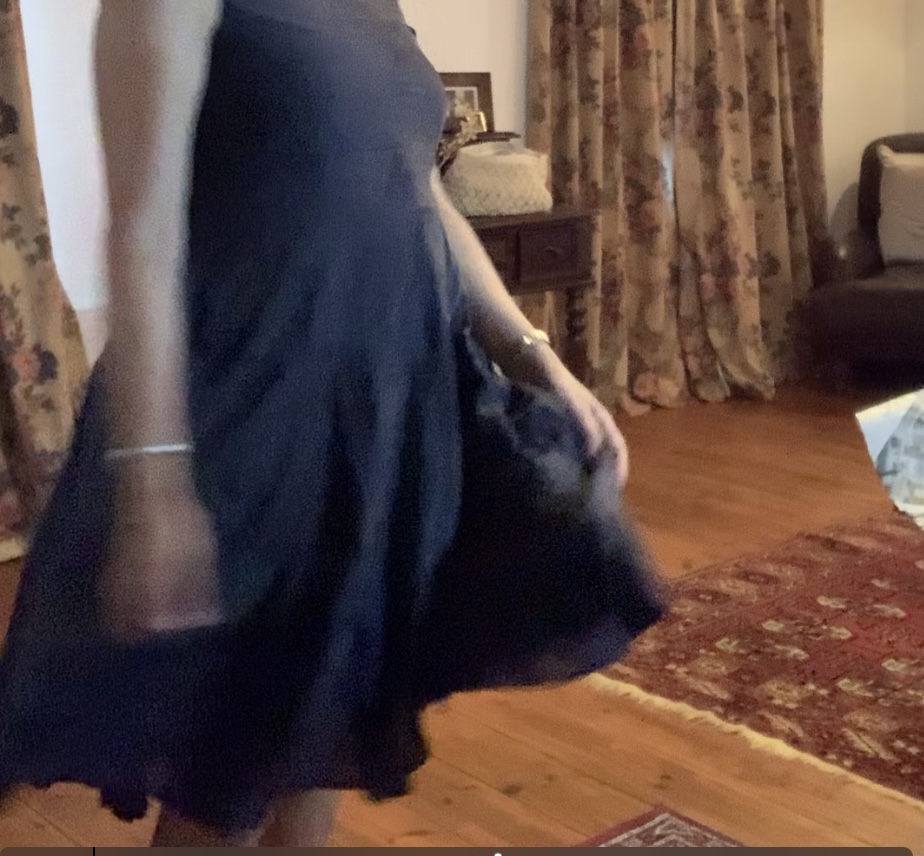
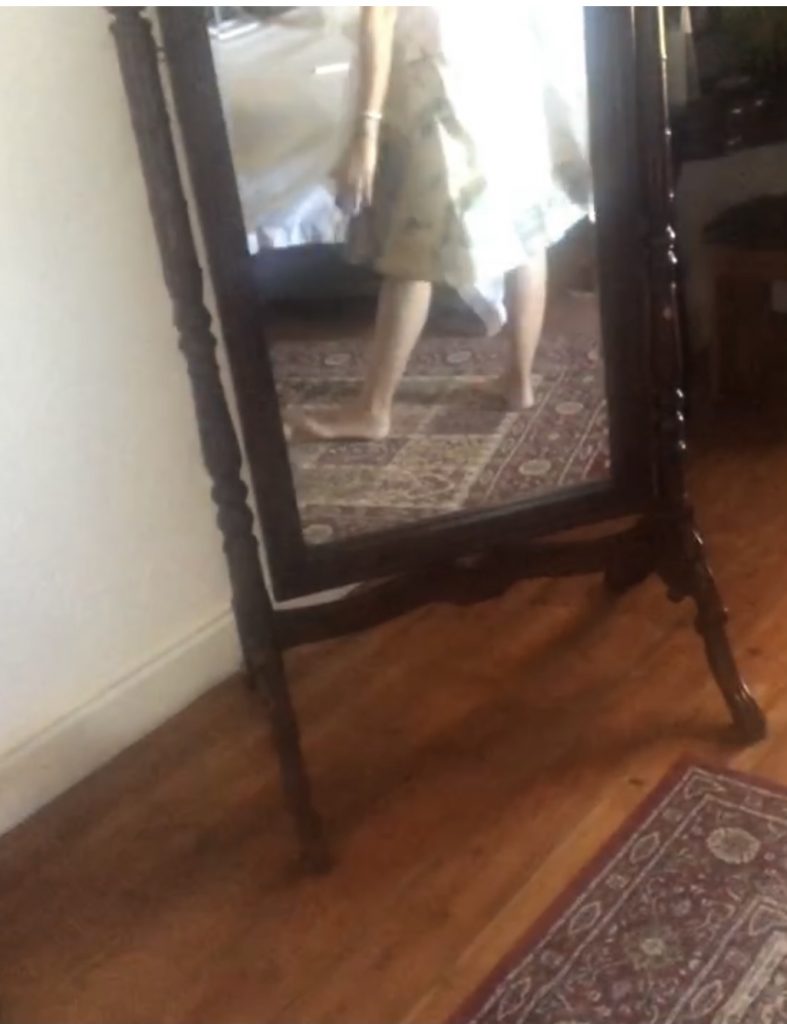
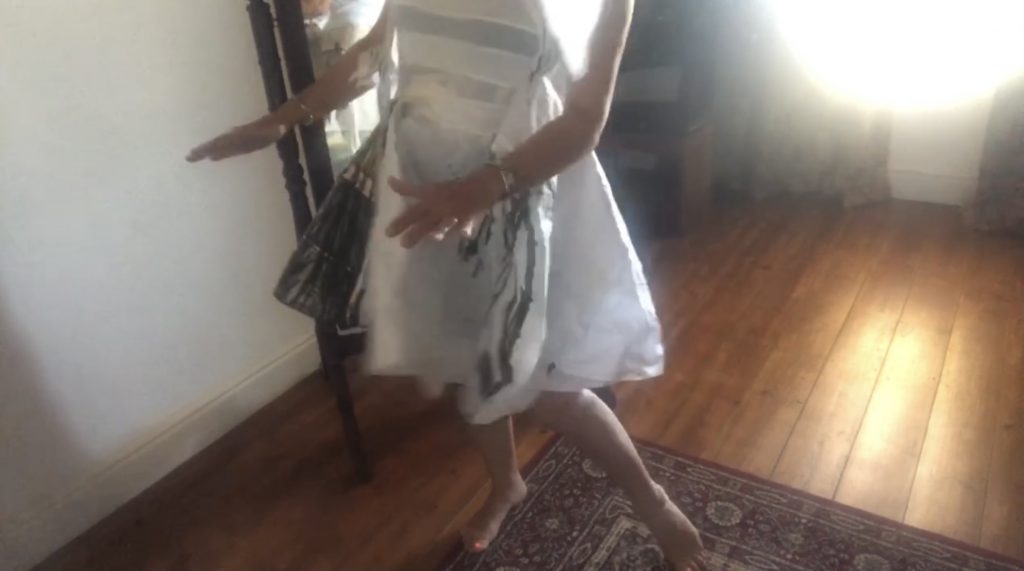
List of Illustrations
Fig. 1 Stander, K. (2021) Collage paper dolls. [Cut out paper, charcoal, acrylic]In possession of: the author: Langvlei, Riebeek West.
Fig. 2 Stander, K. (2021) Reflections 1.[Photograph, reflections] In possession of: the author: Langvlei, Riebeek West.
Fig. 3 Stander, K. (2021) Reflections 2 .[Photography, reflections] In possession of: the author: Langvlei, Riebeek West.
Fig. 4 Stander, K. (2021) Mixed media exploration. [Drawings and painting and mirror] In possession of: the author: Langvlei, Riebeek West.
Fig. 6 Stander, K. (2021) Combine. [Exploring ideas of surrealism, cardboard, charcoal and acrylic paint]In possession of: the author: Langvlei, Riebeek West.
Fig. 7 Stander, K. (2021) Dress. [Exploring ideas of fashion, acrylic paint on paper] In possession of: the author: Langvlei, Riebeek West.
Fig. 8 Stander, K. (2021) Combine. [Different view of work in paper, acryl and charcoal]In possession of: the author: Langvlei, Riebeek West.
Fig. 9 Stander, K. (2021) Combine. [Paper, acrylic, and charcoal] In possession of: the author: Langvlei, Riebeek West.
Fig. 10 Stander, K. (2021) Combine with robe. [Continued exploration of same painting]In possession of: the author: Langvlei, Riebeek West.
Fig. 11 Stander, K. (2021) Combine with aluminum foil. [Continued exploration of same painting]In possession of: the author: Langvlei, Riebeek West.
Fig. 12 Stander, K. (2021) Combine with wire and rope. [Continued exploration of same painting]In possession of: the author: Langvlei, Riebeek West.
Fig. 13 Stander, K. (2021) Paperdress combine [Continued exploration with paper dress and Combine]In possession of: the author: Langvlei, Riebeeck West.
Fig. 14 Stander, K. (2021) Exploration on floor no 1. [paper dress] In possession of: the author: Langvlei, Riebeek West.
Fig. 15 Stander, K. (2021) Exploration on floor no 2.[paper dress] In possession of: the author: Langvlei, Riebeek West.
Fig. 16 Stander, K. (2021) Exploration on floor no 3. [paper dress] In possession of: the author: Langvlei, Riebeek West.
Fig. 17 Stander, K. (2021) Paper dress on floor no 4. [Exploration of paper dress on floor] In possession of: the author: Langvlei, Riebeek West.
Fig. 18 Stander, K. (2021) Paper dress on floor no 5 . [Exploration on the floor] In possession of: the author: Langvlei, Riebeek West.
Fig. 19 Stander, K. (2021) Paper dress on floor no 6. [Exploration on the floor] In possession of: the author: Langvlei, Riebeek West.
Fig. 20 Stander, K. (2021) Paperdress on Umbrella. [Exploration of paper dress on an umbrella] In possession of: the author: Langvlei, Riebeek West.
Fig. 21 Stander, K. (2021) Paperdress Combine with Infanta painting. [painting and paper]In possession of: the author: Langvlei, Riebeek West.
Fig. 22. Stander, K. (2021) Paperdress Combine with Infanta painting 2. [Combination of paper dress, red plastic cup and painting]In possession of: the author: Langvlei, Riebeek West.
Fig. 23 Harpers Bazaar Arabia (2021) Azza Slimene On Gender Equality, Fighting Negativity And Being Proud To Be Arab. [Culture news] At: https://www.harpersbazaararabia.com/culture/culture-featured-news/tunisian-model-actress-azza-slimene-interview (Accessed on 03/12/2021).
Fig. 24 Harpers Bazaar Arabia (2021) Dress, POA, Fendi. [Culture news] At: https://www.harpersbazaararabia.com/culture/culture-featured-news/tunisian-model-actress-azza-slimene-interview (Accessed on 03/12/2021).
Fig. 25 Stander, K. (2021) Drawing start 1 [Drawing in charcoal on paper]In possession of: the author: Langvlei, Riebeek West.
Fig. 26 Stander, K. (2021) Drawing development. [charcoal on paper] In possession of: the author: Langvlei, Riebeek West.
Fig. 27 Stander, K. (2021) Air balloon. [Drawing in charcoal on paper]In possession of: the author: Langvlei, Riebeek West.
Fig. 28 Stander, K. (2021) Dress as air balloon. [Drawing with soft pastels on paper]In possession of: the author: Langvlei, Riebeek West.
Fig. 29 Tjaerandsen F. (2019) Orange dress. [Photograph] At: https://www.designboom.com/design/fredrik-tjaerandsen-balloon-dresses-csm-graduate-fashion-show-06-03-2019/ (Accessed on 05/12/2021)
Fig. 30 Tjaerandsen F. (2019) Yellow bubble. [Photograph] At: https://designboom.com/design/fredrik-tjaerandsen-balloon-dresses-csm-graduate-fashion-show-06-03-2019/ (Accessed on 05/12/2021)
Fig. 31 Stander, K. (2021) Floating upside down. [Oil paint on canvas paper]In possession of: the author: Langvlei, Riebeek West.
Fig. 32 Leigh, Simone. (2019) Las Meninas. [Photograph] At: https://www.clevelandart.org/magazine/cleveland-art-marchapril-2020/acquisitions-2019 (Accessed on 04/12/2021)
Fig. 33 Stander, K. (2021) Dress: a balloon. [Oilpaint on canvas paper]In possession of: the author: Langvlei, Riebeek West.
Fig. 34 Stander, K. (2021) Las Menina WIP. [oilpaint on canvas paper] In possession of: the author: Langvlei, Riebeek West.
Fig. 35 Stander, K. (2021) Black-dress and Las Meninas. [Oilpaint on canvas paper]In possession of: the author: Langvlei, Riebeek West.
Fig. 36 Morrissey Trisch (2004 ) Eighteen to Forty-Five .[Screenshot] At: https://trishmorrissay.com (Accessed on 04/12/2021)
Fig. 37 Stander, K (2021) Unconstrained Movement. [Video] In possession of: the author: Langvlei, Riebeek West.
Fig. 38 Stander, K. (2021) Dancing in black dress. [Video still] In possession of: the author: Langvlei, Riebeek West.
Fig. 39 Stander, K (2021) Reflection in mirror. [Video still]In possession of: the author: Langvlei, Riebeek West.
Fig. 40 Stander, K (2021) Dancing in paper . [Video still] In possession of: the author: Langvlei, Riebeek West.
Bibliography
Barthes, Roland. (1980) Camera Lucida: Reflections on Photography, translated by Richard Howard. Monoskop ebook downloaded as a PDF. At: https://monoskop.org/images/c/c5/Barthes_Roland_Camera_Lucida_Reflections_on_Photography.pdf (Accessed on 04/12/2021)
Brown, Heather L, Virginia N and Barbato, Randaal J. (2019) Acquisitions 2019: Highlights of work that joined the collection last year. At: https://www.clevelandart.org/magazine/cleveland-art-marchapril-2020/acquisitions-2019 (Accessed on 02/12/2021)
Le John, Mica. (2018) Review of Documents of Contemporary Art. Volume 61 Number 4 October 2018. At: file:///Users/cwstander/Library/Mobile%20Documents/com~apple~CloudDocs/Documents/OCA/Studio%20Practice/cura%20the%20museum%20journal.12275.pdf (Accessed on 12/12/2021)
Morrissey, Trish. (2004) Eighteen to Forty-Five on the website of the artist. At: https://trishmorrissay.com (Accessed on 04/12/2021)
Small, Jocelyn Penny. (1999) ‘Time in Space: Narrative in Classical Art.’ in The Art Bulletin, vol. 81, no. 4, [Taylor & Francis, Ltd., College Art Association] pp. 562–75. At: https://doi.org/10.2307/3051334 (Accessed 02/11/2021).